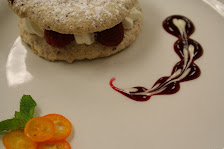Day 12: Jell-O. Jet-Puffed. Cool Whip.
Today’s lesson began with the revelation that some restaurants charge you a lot of money for a dessert called gelée, which is to say, Jell-O. There is more gelatine in the prepackaged variety, so it gets a bit firmer, and making your own from scratch is fifteen seconds slower; these seem to be the cardinal differences between the two. With a sigh of collective disappointment, we shelved the idea of starting class with a cornet session so our gelée would have time to firm up by the end of class.
It turns out that the Jell-O people aren’t that far off, if we assume that what we made tonight was the real thing. Who could forget the craze that started a few years ago, when people began using Champagne (or, more probably, “champagne”) as the liquid in their holiday Jell-O creations? (I seem to recall that it was right around the time that the good folks at Jell-O came out with the White Grape flavor. No disrespect to Jell-O, but Champagne is already flavored like white grapes.) The conflict here, then, is forcing ourselves, some of us who have been labeled “food snobs,” to do one of two things: either we ignore the fact that we consider gelée fancy and Jell-O not, or we allow our estimation of Jell-O to be elevated a bit. I think I’ll choose the latter, if only because it’s satisfying to admit I can allow for some personal growth.
The one freedom gelée-making does allow us, though, is choice of flavors. We were warned off the recipe in our texts for Belgian beer gelée; Chef said that although it sounds intriguing to almost everyone it tends to be the one most often left behind. I suppose it makes sense, since nothing would offend the sensibilities of a Belgian beer lover like tossing in a bunch of sugar. What my new partner this week and I decided to do was make a two-layer gelée (this is sounding more like a church picnic all the time, isn’t it?), the lower layer of which was Champagne gelée, the upper, Champagne and mint gelée. It wasn’t set before class finished, but if it’s as good as it seems like it should be, I’d say we’re in for a treat when we return and unwrap it. At the beginning of class, the Chef demoed pomegranate gelée, which he later topped with sweetened crème fraîche. Especially due to the whipped topping, I was reminded yet again of an ecclesiastical pot-luck, until I swooned over a spoonful of it.
Our next project was classic vanilla panna cotta, infused with the thinnest hint of lemon. Panna cotta is closest in texture to a custard, but it takes mounds less time to prepare since it’s thickened and set with gelatine (see the theme yet?), rather than very cautiously coagulated egg. While there’s little point in trying to imitate custard, panna cotta is awfully delightful in its own right, and I can’t wait to taste ours after it’s had some time to set up. I have no idea what happened to it, truthfully; I remember making it, and pouring it into molds, but after that it just seems to have disappeared. And my pants are still fitting far too comfortably for it to have disappeared to the usual place. Hopefully my partner wrapped and refrigerated it.
Our next variation on the gelatine theme was marshmallows. There were a list of options as to flavors we could choose to make, such as vanilla, rose, lemon, and so forth. I deeply wanted to avoid that lingering nursing-home feel which I still can’t help associating with rose-flavored things, and lemon just seemed odd. We had had such success in dreaming up the Champagne and mint gelée that we decided to stick with the mint theme. Apart from the one student of questionable judgment who deemed them Colgate-flavored, they were pretty enjoyable, and more than one of us could imagine them floating on top of a profoundly satisfying cup of hot chocolate.
Staying on the gelatine highway but rapidly changing lanes, we came to chocolate mousse. This was one of the most complicated recipes we’ve done, involving heating several different ingredients at various times so they could be added swiftly and at the correct temperature. It also required us to fold ingredients together quickly, a major source of angst for learning bakers. To do it properly you must be gentle, so you don’t deflate the whipped cream, but decisive, so the coldness of the cream doesn’t cause the gelatine to set, which would create lumps. Oddly, given all these conditions, nearly all of us turned out very decent chocolate mousse. I felt strangely undeserving of my success.
Egg white, sugar, and gelatine, alone or together, especially, go a long way toward making life very sticky. After we had cleaned up this gooey kitchen, we of course came back to cornets. Suffice it to say that Chef had us repeat the last design we had learned, and then do variations on it.
Which I felt I had really been doing all along.
Tuesday, December 19, 2006
Subscribe to:
Post Comments (Atom)































































No comments:
Post a Comment